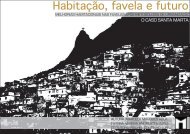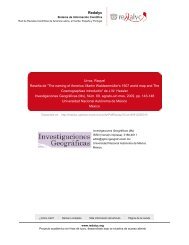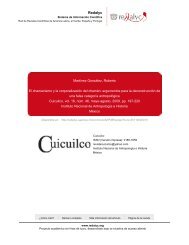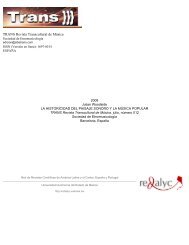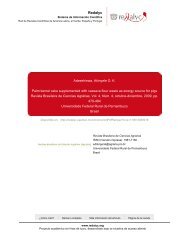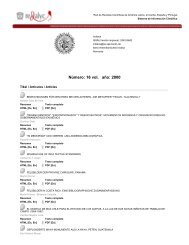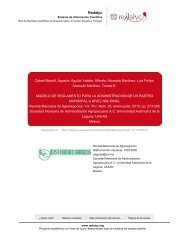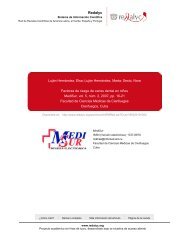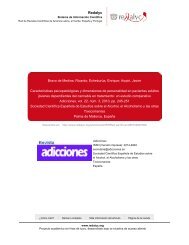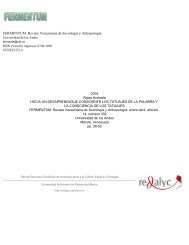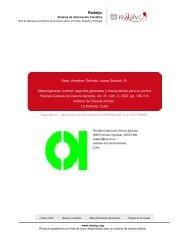Redalyc.Influencia de la cosmovisión del pueblo mixteco de ...
Redalyc.Influencia de la cosmovisión del pueblo mixteco de ...
Redalyc.Influencia de la cosmovisión del pueblo mixteco de ...
You also want an ePaper? Increase the reach of your titles
YUMPU automatically turns print PDFs into web optimized ePapers that Google loves.
Griselda Hernán<strong>de</strong>z, Ramón Mariaca, Miguel Ángel Vásquez y Enrique Eroza<br />
Abstract<br />
In the Mesoamerican cosmovision, nature, the source of natural resources for<br />
the subsistence of human beings, is consi<strong>de</strong>red as a living and sacred entity.<br />
This concept, combined with the holistic view of the human-environment<br />
re<strong>la</strong>tionship and the systematic knowledge of the movement of the stel<strong>la</strong>r<br />
bodies and the immediate surroundings, are the foundations of the traditional<br />
strategies for the management and conservation of natural resources. In this<br />
work, the overall objective was to i<strong>de</strong>ntify and analyze the cultural foundations<br />
that govern the use of dye produced by the purple snail Plicopurpura pansa,<br />
which has been used traditionally by the dyers of Pinotepa <strong>de</strong> don Luis, for<br />
dyeing Mixteco´s cotton textiles. The investigation was based on the procedures<br />
re<strong>la</strong>ted to Groun<strong>de</strong>d Theory and its methodical tools. As a result, the<br />
mythical conceptions of the phenomena and elements that infl uence the use<br />
of the dye produced by the purple snail were the central subject. A refl exive<br />
analysis of this category revealed that one of the points ma<strong>de</strong> in the Mixtec<br />
thought is the persistence of a female conception of the environment. Specifi<br />
cally, the conceptions about yoo (moon), ndikaandii (sun), Nduta ñuu (<br />
“sea”) and Dzavui (rain) regu<strong>la</strong>ting the use of the purple snail.<br />
12<br />
Key words: Mixtec culture, Marine Resource Management, Natural Dyes,<br />
Gen<strong>de</strong>r and Environment, Plicopurpura pansa.<br />
Griselda Ma. Eugenia Hernán<strong>de</strong>z Rodríguez. Mexicana. M. C. en Recursos<br />
naturales y Desarrollo Rural por El Colegio <strong>de</strong> <strong>la</strong> Frontera Sur. Áreas <strong>de</strong> interés:<br />
Etnoecología y Filosofía prehispánica; oncecoatl@yahoo.com.mx.<br />
Ramón Mariaca Mén<strong>de</strong>z. Mexicano. Doctor en Ciencias en Antropología<br />
social. Investigador asociado “C” <strong>de</strong>l El Colegio <strong>de</strong> <strong>la</strong> Frontera Sur, Áreas<br />
<strong>de</strong> investigación e interés: Cultura y tecnología agríco<strong>la</strong> tradicional, Etnobiología.<br />
Miguel Angel Vásquez Sánchez. Mexicano. Candidato a Doctor en Ciencias<br />
Ambientales. Técnico titutar “C” <strong>de</strong>l El Colegio <strong>de</strong> <strong>la</strong> Frontera Sur. Áreas<br />
<strong>de</strong> investigación e interés: Conservación <strong>de</strong> recursos naturales, Interacciones<br />
ambientales urbano-rurales.<br />
Enrique Eroza So<strong>la</strong>na. Mexicano. Doctor en Antropología social. Investigador<br />
asociado “A” <strong>de</strong> El Colegio <strong>de</strong> <strong>la</strong> Frontera Sur. Áreas <strong>de</strong> interés:<br />
Antropología simbólica, Antropología médica, Religión.<br />
Estudios sobre <strong>la</strong>s Culturas Contemporáneas



